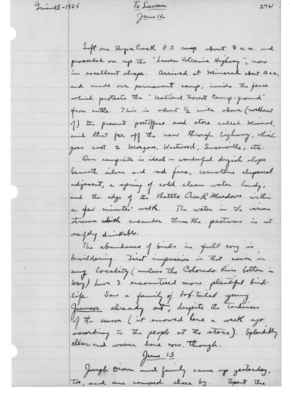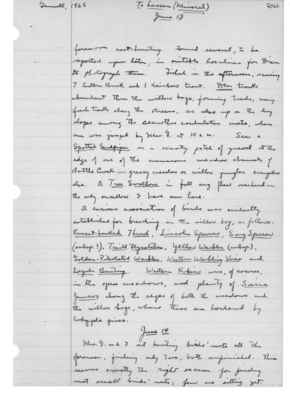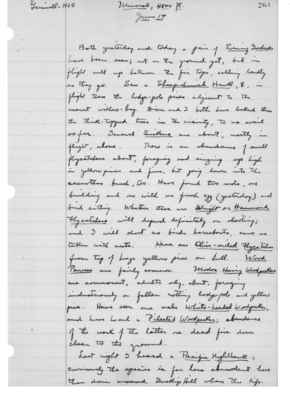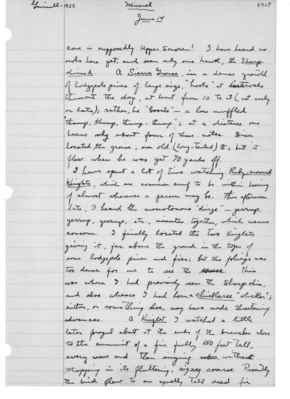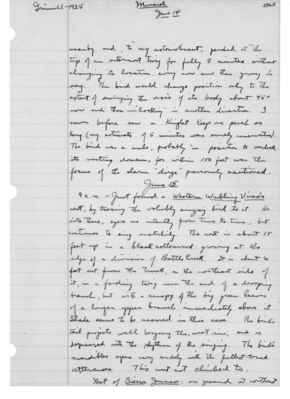Pages
S2 Page 5
Collector: Grinnell - 1925 Location: Lassen Section Date: June 12-13, 1925 Page Number: 2461
Left our Payne Creek P.O. camp about 8 a.m. and proceeded on up the "Lassen Volcanic Highway", now in excellent shape. Arrived at Mineral about 10 a.m., and made our permanent camp, inside the fence which protects the "National Forest Camp-ground" from cattle. This is about 1/2 mile above (northeast of) the present postoffice and store called Mineral, and that far off the new thorough highway, which goes east to Morgan, Westwood, Susanville, etc. Our campsite is ideal - wonderful dryish slope beneath silver and red firs, ceanothus chaparral adjacent, a spring of cold clean water handy, and the edge of the Battle Creek Meadows within a few minutes' walk. The water in the various streams which meander thru the pastures is not safely drinkable. The abundance of birds in full song is bewildering. First impression is that never in any locality (unless the Colorado River bottom in May) have I encountered more plentiful bird life. Saw a family of bob-tailed young Juncos already out, despite the tardiness of the season (it snowed here a week ago according to the people at the store). Splendidly clean and warm here now, though. June 13, 1925. Joseph Dixon and family came up yesterday, too, and are camped close by. Spent the
S2 Page 6
Collector: Grinnell - 1925 Location: Lassen Section (Mineral) Date: June 13-14, 1925 Page Number: 2462
forenoon nest-hunting. Found several, to be reported upon later, in suitable locations for Dixon to photograph them. Fished in the afternoon, securing 7 Eastern Brook and 1 Rainbow Trout. Deer tracks abundant thru the willow bogs, forming trails; many fresh tracks along the streams, as also up on the dry slopes among the Ceanothus cordulatus mats, where one was jumped by Mrs. G at 10 a.m. Saw a Spotted Sandpiper on a scanty patch of gravel at the edge of one of the numerous meadow channels of Battle Creek - grassy meadows on willow jungles everywhere else. A Tree Swallow in full song flew overhead - the only swallow I have seen here. A curious association of birds was evidently established for birding in the willow bog, as follows: Russet-backed Thrush, Lincoln Sparrow, Song Sparrow (subsp.?), Traill Flycatcher, Yellow Warbler (subsp.), Golden-Pileolated Warbler, Western Warbling Vireo and Lazuli Bunting. Western Robins were, of course, in the open meadows, and plenty of Sierra Juncos along the edges of both the meadows and the willow bogs, where these are bordered by lodgepole pines. June 14 Mrs. G. and I out hunting birds' nests all the forenoon, finding only two, both unfinished. This seems exactly the right season for finding most small birds' nests; few are sitting yet.
S2 Page 7
Collector: Grinnell - 1925 Location: Lassen Section (Mineral) Date: June 14, 1925 Page Number: 2463
Both yesterday and today a pair of Evening Grosbeaks have been seen; not on the ground yet, but in flight well up between the fir tops, calling loudly as they go. Saw a Sharp-shinned Hawk, female, in flight thru the lodge-pole pines adjacent to the nearest willow-bog. Dixon and I both have looked thru the thick-topped trees in the vicinity, to no avail so far. Several Siskins are about, mostly in flight, above. There is an abundance of small flycatchers about, foraging and singing up high in yellow pines and firs, but going down into the ceanothus bush, too. Have found two nests, one building and one with one fresh egg (yesterday) and bird sitting. Whether these are Wright or Hammond Flycatchers will depend definitely on shooting; and I will shoot no birds hereabouts, save any (?) taken with nests. Hear one Olive-sided Flycatcher from top of huge yellow pine on hill. Wood Pewees are fairly common. Modoc Hairy Woodpeckers are commonest, adults only, about, foraging industriously on fallen rotting lodge-pole and yellow pine. Have seen one male White-headed Woodpecker, and have heard a Pileated Woodpecker; abundance of the work of the latter on dead firs down clean to the ground. Last night I heard a Pacific Nighthawk; curiously this species is far less abundant here than down around Inskip Hill where the life-
S2 Page 8
Collector: Grinnell - 1925 Location: Lassen Section (Mineral) Date: June 14, 1925 Page Number: 2464
zone is supposedly Upper Sonoran! I have heard no owls here yet, and seen only one hawk, the Sharp shinned. A Sierra Grouse, in dense growth of lodgepole pines of large size, "hoots" at intervals thruout the day, at least from 10 to 3 (not early or late); rather, he "boonts" - a low muffled "thump, thump, thump, thump"; at a distance one hears only about four of these notes. Dixon located the grouse, an old (long-tailed) female, but it flew when he was yet 70 yards off. I have spent a lot of time watching Ruby-crowned Kinglets, which are common enuf to be within hearing of almost wherever a person may be. This afternoon late, I heard the monotonous "dinge", yerrup, yerrup, yerrup, etc., minutes together, which means concern. I finally located the two Kinglets giving it, far above in the tops of some lodgepole pines and firs; but the foliage was too dense for me to see the cause. This was where I had previously seen the Sharpshin, and also whence I had hear a chickadee "chicken"; either, or something else, may have made threatening advances. A Kinglet I watched a little later foraged about at the end of branches close to the summit of a fir fully 150 feet tall, every now and then singing without stopping it its fluttering, zigzag course. Presently the bird flew to an equally tall dead fir
S2 Page 9
Collector: Grinnell - 1925 Location: Lassen Section (Mineral) Date: June 14-15, 1925 Page Number: 2465
nearby and, to my astonishment, perched at the top of an outermost twig for fully 5 minutes without changing its location, every now and then giving its song. The bird would change position only to the extent of swinging the axis of its body about 45° now and then - "looking" in another direction. I never before saw a Kinglet keep one perch so long (my estimate 15 minutes was surely conservative). The bird was a male, probably in position to overlook its nesting domain, for within 100 feet was the focus of the alarm "dinge" previously mentioned. June 15 9 a.m. - Just found a Western Warbling Vireo's nest, by tracing the volubly singing bird to it. He sits there, eyes me intently from time to time, but continues to sing snatchily. The nest is about 18 feet up in a black cottonwood growing at the edge of a division of Battle Creek. It is about 6 feet out from the trunk, on the northeast side of it, in a forking twig near the end of a drooping branch, but with a canopy of the big green leaves of a longer upper branch immediately above it. Shade seems to be assured in this case. The birds' tail projects well beyond the nest rim, and is depressed with the rhythm of the singing. The birds' mandibles open very widely with the fullest-toned utterances. This nest not climbed to. Nest of Sierra Junco: on ground at northeast.
